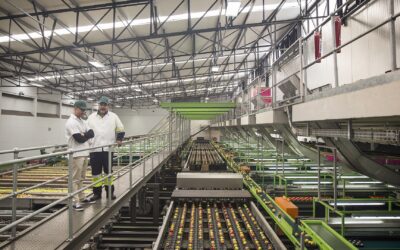Practical Application
Much has been said about the benefits Industry 4.0 technologies can provide to manufacturers of all sizes. But what does it actually look like when these technologies are leveraged to improve a business? For a more detailed picture, let’s walk through the stages of business maturity.
The model we will use encompasses the following maturity stages: Reactive, Cognitive, Preventive, Predictive and Autonomous. With this model in mind, how can an organization reach the upper level of flexibility and autonomy, where deviations are detected and responded to (correctly) by the appropriate (lowest possible) level of the organization?
A business starts out as reactive, where a centralized group of decision-makers attempt to resolve issues with little to no advanced warning in a ritual we affectionately call “firefighting.” To escape the constant chaos of their reactionary existence, the organization takes specific steps to improve their management to the cognitive level. The introduction of metrics and measurements provides the first clear glimpse of performance, allowing workers to locate sources of variation. Standard systems and procedures are then put in place and serve to stabilize the environment, as well as enable the business to operate in a preventive manner. Soon it becomes obvious which issues are resulting in poor performance. Reaction plans are implemented to ensure effective and timely responses to minimize the impact of variation. Additionally, focused projects are improved to empower the organization to predict situations that cause variation. Now a predictive organization, the business begins to foresee these situations and is able to identify and implement improvements in processes, products and services to eliminate occurrences of variation. Each step moves the process closer to the desired level of flexibility until the organization performs more like an organism, with each part reacting autonomously to support the well-being of the whole.
Technology Can Help You “Get There”
Guiding a business to become a learning organization is a challenge. A lot of heavy lifting can be involved and, quite frankly, many people are so tied up in day-to-day operations that trying to find the time and information to work on the business can be difficult. Unless a company is blessed with a “people closet” to supply additional support, the efforts may fall short in either resource or priority, causing the improvement initiatives to fail. To combat this challenge, leveraging technology can reduce the resource drain on the leadership team and result in improvements that are not only realized faster, but are easier to sustain and build on in the future. Let’s consider the benefits of using technology to assist in each level of business maturation.
Beginning in the reactive phase, an organization “does not know what they do not know,” so they must begin gathering data to gain more insight into the strengths and weaknesses of their current practices. However, asking people who are already task-saturated to fill out additional paperwork is never a popular move – and it doesn’t stop there. That paperwork must be collected, tracked, compiled, reported and shared before it can even be considered. This additional demand on resources can result in failures to collect data as well as delays in receiving it. Using sensors and the Industrial Internet of Things (IIOT), the data collection process can be automated so that additional burden is not placed on team members. And, rather than keeping file cabinet after file cabinet of stored sheets, the data can be saved electronically on-site or in the cloud in a secure manner.
But data is just data until it is actually analyzed and turned into information. It is only then that the organization “knows what they don’t know,” growing in maturity in the process. They also learn that there are pockets of information existing which should be available to a larger number of team members. Using dashboards to provide real-time information and system integration, a greater number of resources can be used to understand the information and identify ways to prevent, and eventually predict, when a negative or unusual outcome is about to occur. Since the Big Data generates itself, the information available will be much larger and more accurate than ever. As the team begins to identify Key Input Variables (also known as leading indicators), they can use the integrated systems and dashboards to communicate the likelihood of issues before they occur, effectively operating as a predictive organization, allowing the team enough time to take appropriate actions.
Once the organization embarks on the journey of optimizing business practices, technology should again be considered. For example, if inspection failures are an issue, can the process be automated through cobotics/robotics to ensure 100% performance of the task or to reduce measurement inaccuracies? Can augmented reality be used to provide relevant data in real time or to assist team members in achieving a higher level of training? Through simulation and virtualization, can failure modes be better predicted and then eliminated? And finally, could your product be better made using additive technologies rather than subtractive? Leveraging technology at this level to support product, workforce and process improvements can ultimately help a company achieve and maintain autonomous manufacturing.
Manufacturers often are intimidated by technological implementations due to the high costs, time and labor they assume they will have to invest. But, if effectively applied, technology can help team members achieve a new level of efficiency through the delivery of real-time information.
To assist Michigan’s small to mid-sized manufacturers with understanding and adopting Industry 4.0 technologies, the Michigan Manufacturing Technology Center (The Center) is partnering with the Michigan Economic Development Corporation (MEDC) and Automation Alley to drive awareness of the many uses and benefits of these innovations. From conducting an initial Technology Opportunity Assessment with calculated ROI to identifying and applying relevant technologies, The Center guides manufacturers through their technological implementations in a way that makes sense for their businesses. Learn more about how The Center can support your company’s Industry 4.0 journey by contacting inquiry@the-center.org or visit the-center.org.
Chuck Werner is a Manager of Operational Excellence and Lean Six Sigma Master Black Belt at the Michigan Manufacturing Technology Center. As part of The Center’s Industry 4.0 Core Team, Chuck helps drive the company’s mission to advance Michigan manufacturing by combining continuous improvement methodologies with modern manufacturing technologies.



